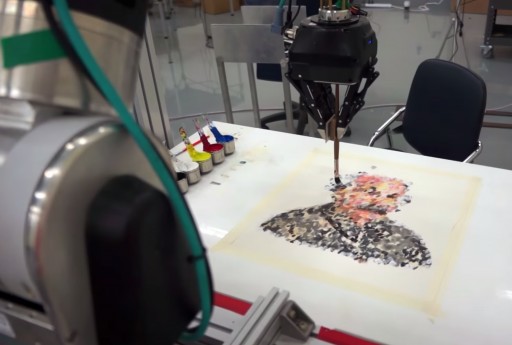
Seattle, Washington - April 29, 2016 - (Newswire.com)
In 1953, painter Paul Klee described the creative process as a feedback loop where artists continually switch between “making a mark on canvas, perceiving the effect, and reacting with a further mark,” over and over again until the completion of an artwork. At least three robots in the first annual international Robot Art Contest have utilized this concept to blur the line between human and machine creativity. These robots are eDavid of Germany, TAIDA of Taiwan, and cloudPainter of the United States.
Not only do each of these robots mimic human artists by painting with a brush, but they also have a camera watching the canvas they are painting. Similar to how artists take a step back to evaluate their work, these cameras are continually watching the canvas, or in Paul Klee’s words “perceiving the effect” of their painting. With each brushstroke, these robots compare the canvas to the image they are trying to paint, and evaluate their own progress to decide the next strokes.
The specifics of how each robot evaluates its work differs, though the explanation provided by each team sounds remarkably similar to an artist describing their creative process.
eDavid’s creators Oliver Deussen and Thomas Lindemeier write that “Painting can be seen as an optimization process in which color is manually distributed on a canvas until one is able to recognize the content.” Their robot sets out to demonstrate this approach by beginning with a picture and applying brushstrokes, evaluating each stroke as it works towards an optimized ideal. eDavid’s paintings begins as a blurred image that sharpens over time as the robot optimizes an image into existence.
TAIDA, the creation of Ming-Jyun Hong, employs a more traditional approach to painting. Two aspects of its creative process that make it notable look back to the classical roots of painting. The first is that the robot begins by applying an underpainting to set the tone of the image before working on a refinement layer. The second is that the robot paints from a limited set of pigments that include only cyan, yellow, magenta, black, and white. Like an old master, TAIDA mixes all its paints on a side palette before applying it to the canvas.
Pindar Van Arman’s cloudPainter takes the creative process beyond the canvas and into the realm of creating original compositions. Not only does his robot use feedback loops in an attempt to replicate human creativity, but it also uses algorithms to create unique compositions. When creating portraits, his robot takes its own photographs, selects a favorite based on aesthetic criteria, and then uses further heuristics to crop the photo and select a color palette for it. All this before the painting even begins. His robot then attempts to make the canvas look more like its original composition one brush stroke at a time. Eventually, it observes that new brushstrokes are no longer making the canvas any more like the original composition at which point Van Arman tells us “The robot decides it has done the best it can, and stops.”
While artistic machines have been around for years, these robots represent a new generation of self evaluating creative robots. They create not by random application of paint to a canvas, but by applying intentional brushstrokes in an attempt to achieve an artistic composition. Furthermore, they do not merely execute the instructions of their creators, but attempt to evaluate how well they are progressing towards their own goals and make adjustments based on their own progress. These robots paint with a mixture of rules and serendipity, like a human painter.
While the question remains of whether the robots or their creators are the artists behind these paintings, the creative process is being executed independently by each robot. As these robots are painting without a premeditated plan or set of instructions, it would appear that they are at least simulating creativity. Seeing how close to a human's creative process they are, it is even worth considering whether or not they are achieving actual creativity.
The work of these robots and other competitors can be seen at robotart.org where they are competing for $100,000 in prizes. Voting is open to the public for next several weeks with winners of this inaugural competition being announced on May 15th.
--- Contact Information on Further Resources ---
eDavid, TAIDA, and cloudPainter are currently competing in the 2016 Robot Art Contest against two dozen other teams from 8 countries on 4 continents. Their paintings and the works of all the competitors can be seen at robotart.org. Also feel free to contact the following team captains and the contest organizer for more information about these painting machines and the competition. Also feel free to contact any of following for more images
Oliver Deussen
eDavid
Video: https://www.youtube.com/watch?v=G1nskZgWSSE
oliver.deussen@uni-konstanz.de
Ming Jyun Hong
TAIDA
Video: https://www.youtube.com/watch?v=pV4P6Meltu8
mjhung@ira.ee.ntu.edu.tw
Pindar Van Arman
cloudPainter
Video: https://www.youtube.com/watch?v=qrAnJHKjoh0
pindar.vanarman@gmail.com
Andrew Conru
robotart.org Sponsor and Contest Organizer
Contest Website: robotart.org
abconru@yahoo.com
Contact Info:
RobotArt
Press Release Service by Newswire.com
Original Source: Painting Robots in International Contest Blur Line Between Human and Machine Creativity